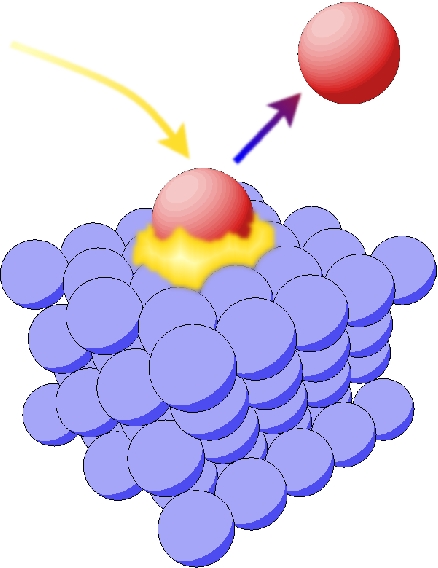Dissociation of O2 from Al(111)

The oxygen interaction with the aluminium surface provides a lot of challenges for theorists: Experiments predict a barrier and related vibrational enhancement for the dissociative sticking of oxygen on the surface[1], which have not been found in common adiabatic DFT calculations[2]. Furthermore the dissociation mechanism and its dynamics still represent a mystery: In 1992 Brune et al. [3] measured that the single dissociated oxygen atoms on the aluminium surface dist up to 80 Å from each other. While first hot adatom diffusion was the preferential explanation for this phenomena, nowadays the scientific community favors a so called "abstraction mechanism": One oxygen atom sticks on the surface, while the other one is catapulted back into the vacuum[4].
On the basis of six-dimensional ab initio potential energy surfaces available by courtesy of J. Behler [5], some preliminary 3D simulations with constant spin-orbit coupling were performed: The sticking coefficient and its vibrational enhancement could be qualitatively reproduced in agreement with experiment. Even quantitative agreement may be expected for 6D mixed quantum-classical simulations. However sticking relies on the dynamics on the early PES, far away from the surface, where the constant spin orbit coupling approximation is justified and no charge transfer towards the surface is relevant.
This is not the case for abstraction, which happens in proximity of the surface: We see some evidence for abstraction due to the non-adiabatic state transitions in our simulations, but there are still a bunch of open questions:
- May additional dimensions provide additional or even stronger steering into the perpendicular orientation?
- Can the relaxation into the adiabatic ground state and the associated charge transfer towards the surface play a major role?
- How does the spin orbit coupling depend upon the molecule-surface distance?
At the moment six-dimensional mixed quantum classical simulations including charge transfer to the surface are in preparation to gain further insight into the complex dynamics of this system.
| [1] | L. Österlund, I. Zoric and B. Kasemo, Phys. Rev. B 55, 15452 (1997) |
| [2] | Y. Yourdshahyan, B. Razaznejad and B. I. Lundqvist, Solid State Comm. 117, 531 (2001) |
| [3] | H. Brune, J. Wintterlin, R. J. Behm and G. Ertl, Phys. Rev. Lett. 68, 624 (1992) |
| [4] | A. J. Komrowski, J. Z. Sexton, A. C. Kummel, M. Binetti, O. Weiße and E. Hasselbrink Phys. Rev. Lett. 87, 246103 (2001) |
| [5] | J. Behler, B. Delley, S. Lorenz, K. Reuter and M. Scheffler Phys. Rev. Lett. 94, 036104 (2005) |

